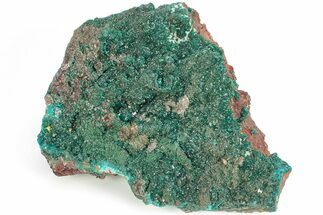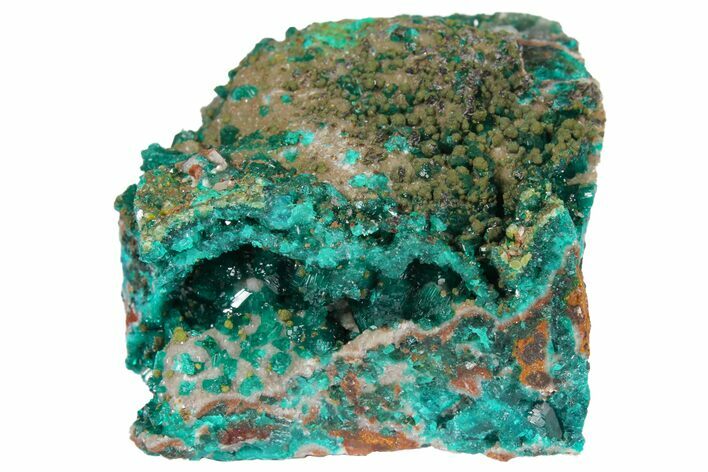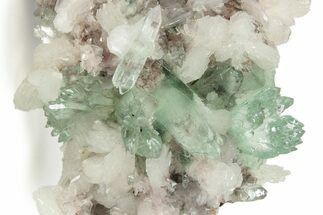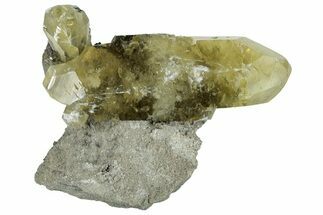This Specimen has been sold.
2.35" Gemmy Dioptase Crystals on Dolomite - Mpita Prospect, Congo
This is a very nice association of dioptase crystals and dolomite from the Mpita Prospect of the Republic of Congo. The entire specimen is 2.35" wide. The dioptase crystals have a saturated, dark emerald-green color and the rock matrix is encrusted in dolomite crystals. The botryoidal olive-green formations at what could be considered the top of the specimen is calcio-duftite, a calcium-bearing variety of duftite. There are also small amounts of yellow-orange mimetite scattered throughout the specimen.
Dioptase is an uncommon mineral, found mostly in desert regions where it forms as a secondary mineral in the oxidized zone of copper sulfide mineral deposits. This copper-based mineral forms small rhombohedral crystals, typically less than 0.75 centimeters in length. It is popular with mineral collectors due to its vibrant color and it is occasionally cut into small emerald-like gems.
Dolomite is an anhydrous carbonate mineral composed of calcium magnesium carbonate (CaMg(CO3)2).
The mineral dolomite crystallizes in the trigonal-rhombohedral system. It forms white, tan, gray, or pink crystals. Dolomite is a double carbonate, having an alternating structural arrangement of calcium and magnesium ions. It does not rapidly dissolve in dilute hydrochloric acid as calcite does. Crystal twinning is common.
Dolomite was first described by Carl Linnaeus in 1768, and in 1791 it was described as a rock by the French naturalist and geologist Déodat Gratet de Dolomieu. He first recognized the material in buildings of the old city of Rome, and later as samples collected in the mountains known as the Dolomite Alps of northern Italy.
The mineral dolomite crystallizes in the trigonal-rhombohedral system. It forms white, tan, gray, or pink crystals. Dolomite is a double carbonate, having an alternating structural arrangement of calcium and magnesium ions. It does not rapidly dissolve in dilute hydrochloric acid as calcite does. Crystal twinning is common.
Dolomite was first described by Carl Linnaeus in 1768, and in 1791 it was described as a rock by the French naturalist and geologist Déodat Gratet de Dolomieu. He first recognized the material in buildings of the old city of Rome, and later as samples collected in the mountains known as the Dolomite Alps of northern Italy.
SPECIES
Dioptase, Calcio-Duftite & Dolomite
LOCATION
Mpita Prospect, Mindoili District, Republic of Congo
SIZE
2.35 x 1.6"
CATEGORY
ITEM
#131263
 Reviews
Reviews














